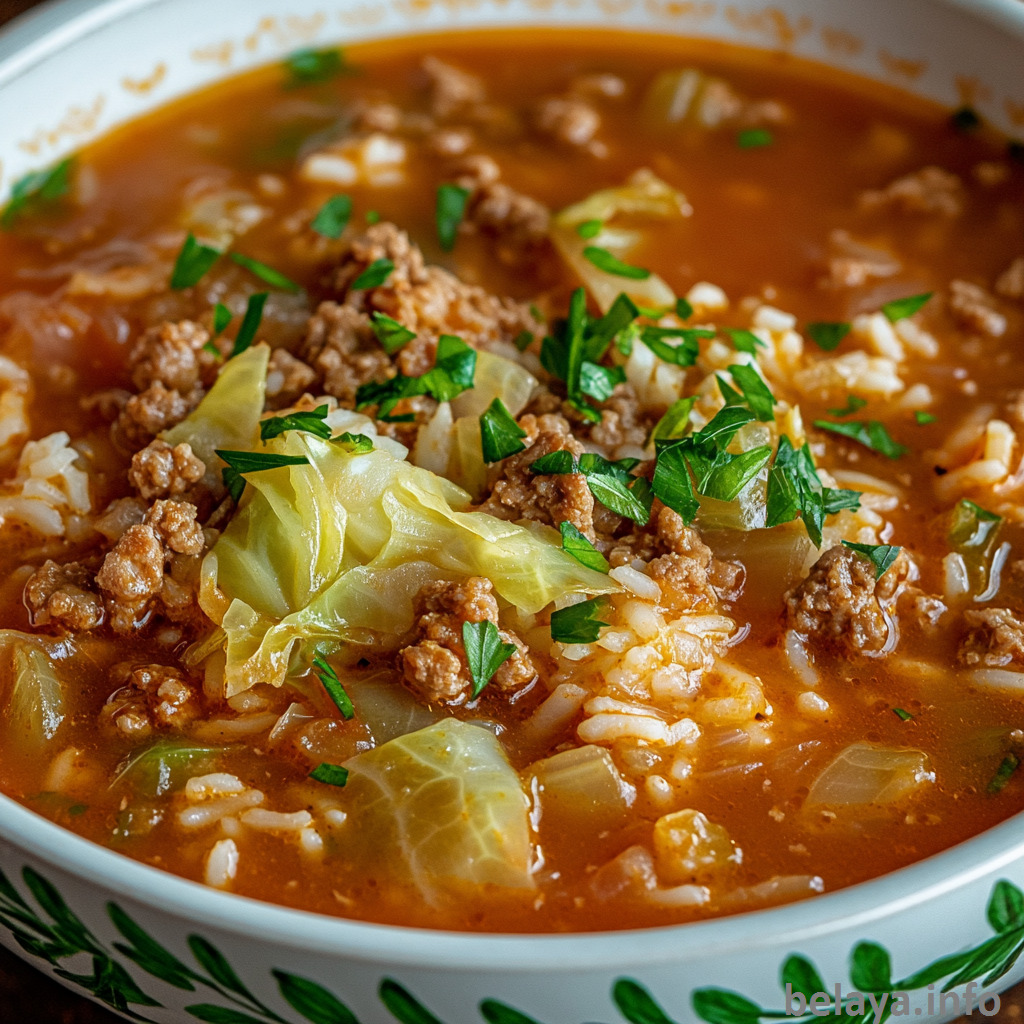Cabbage Roll Soup Recipe
All the comfort of classic cabbage rolls—without the rolling. This Cabbage Roll Soup transforms a labor-intensive dish into a warm, hearty one-pot meal that’s simple to make and rich with flavor.
Tender cabbage, savory ground beef, sweet carrots, and aromatic herbs simmer together with rice in a tangy tomato broth, creating a deeply satisfying bowl that feels both rustic and nourishing.
It’s the kind of soup that warms your kitchen and your soul—perfect for chilly evenings, meal prep, or anytime you’re craving comfort without the fuss.
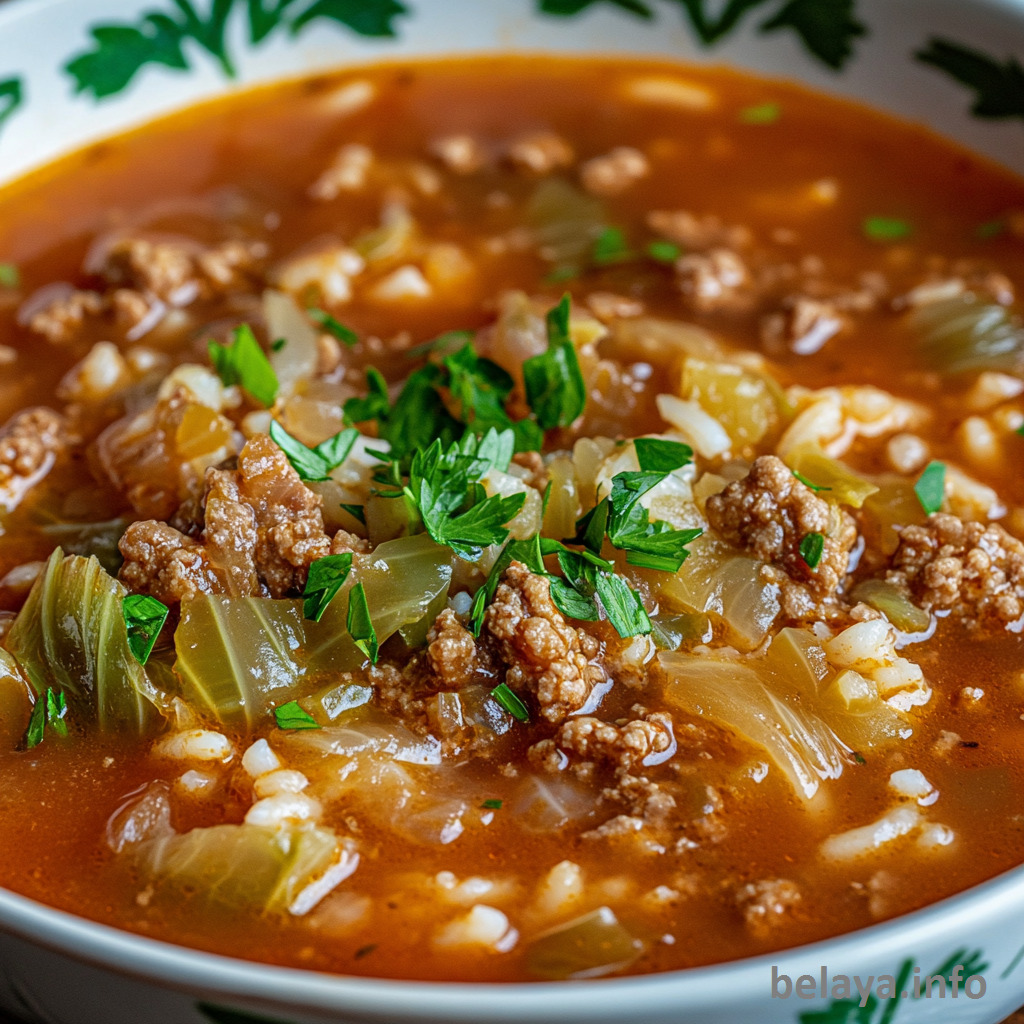
Why People Will Love This Cabbage Roll Soup Recipe:
All the flavor of traditional cabbage rolls—none of the work: This soup captures the essence of classic stuffed cabbage rolls but skips the rolling, layering, and baking. It’s comfort made easy.
Rich, balanced flavors in every spoonful: The combination of ground beef, sweet carrots, tangy tomato sauce, and tender cabbage creates a deep, savory-sweet flavor profile that satisfies from the first bite.
Hearty and filling without being heavy: Thanks to the fiber-rich cabbage, protein-packed beef, and rice, this soup is nourishing and satisfying without feeling overly rich or greasy.
Perfect for meal prep or feeding a crowd: This big-batch soup keeps well, freezes beautifully, and tastes even better the next day—ideal for busy families or make-ahead meals.
A wholesome, nostalgic dish: It evokes the feel of a family kitchen, home-cooked meals, and generations of comfort food tradition—something both familiar and timeless.
Easy to customize: You can adjust the seasoning, use brown rice or cauliflower rice, or even make it vegetarian with lentils or mushrooms instead of beef—it’s versatile and adaptable.
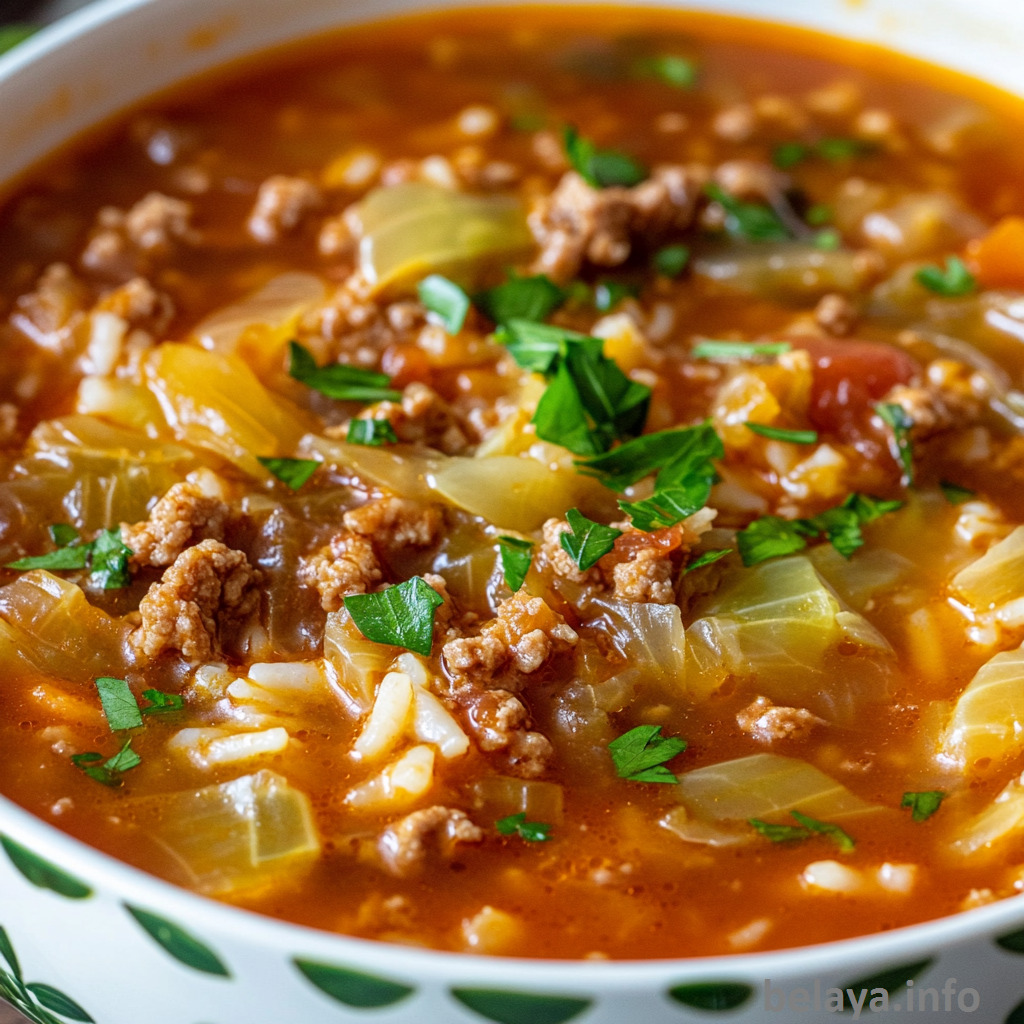
Key Ingredients:
Green cabbage: Earthy and slightly sweet, its sturdy leaves soften into silky ribbons as they simmer, releasing natural sugars that give the broth gentle depth while adding fiber‑rich heft to every spoonful.
Ground beef: A hearty backbone of savory flavor; browning it first builds rich fond at the bottom of the pot, infusing the soup with the familiar, comforting taste of classic cabbage rolls.
Tomato sauce: Bright and tangy, it wraps the ingredients in a mellow acidity that balances the sweetness of the cabbage and carrots, tying all the flavors together with a nostalgic, slow‑stewed warmth.
Long‑grain rice: Cooked directly in the broth, the grains absorb beefy, tomato‑rich juices, swelling into tender bites that mimic the filling of traditional stuffed rolls and make the soup satisfyingly substantial.
Beef broth: A layered, umami‑packed base that amplifies the meatiness of the dish, giving the soup a deep, rounded flavor that tastes like it’s been simmering all day—even when it hasn’t.
Brown sugar & bay leaf: Just a hint of molasses sweetness plus herbal complexity; together they soften the acidity of the tomatoes and add a subtle, almost caramelized note that lingers pleasantly on the palate.
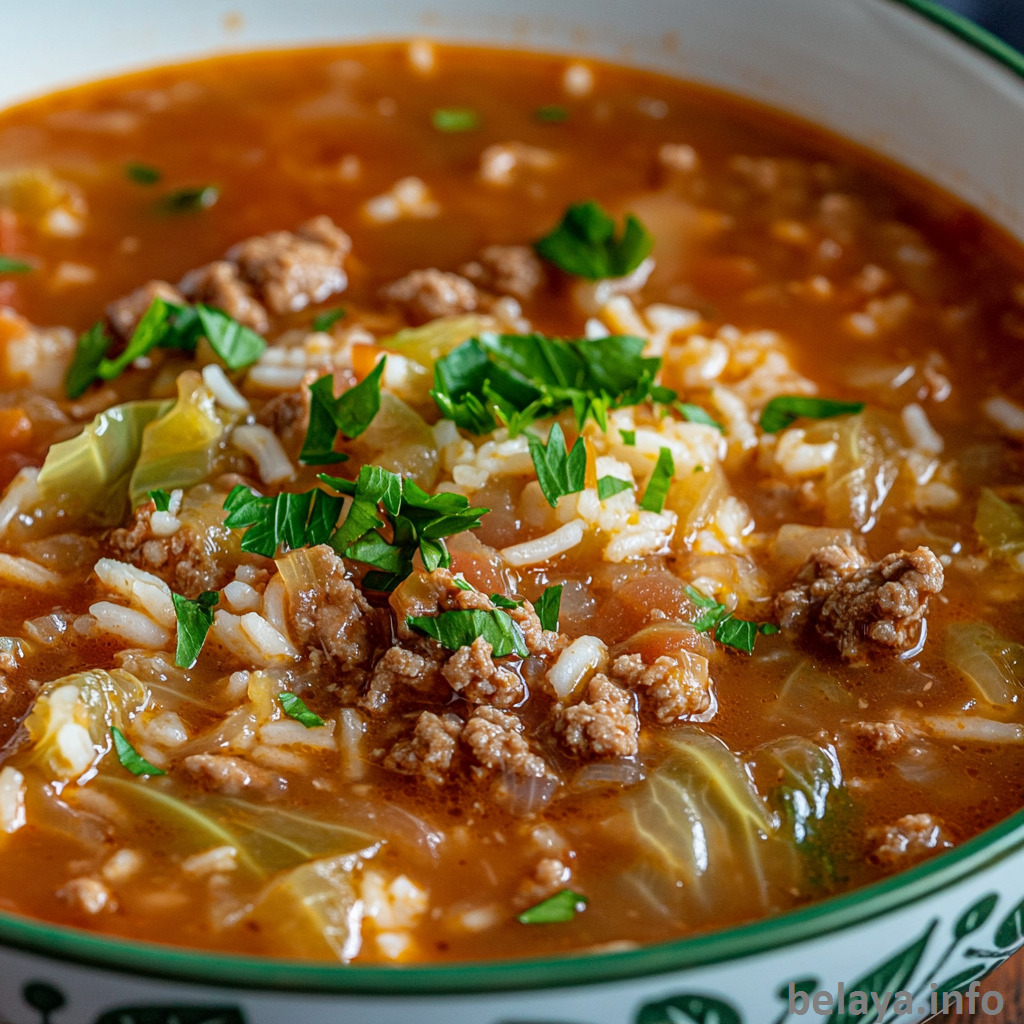
Expert Tips:
Brown the beef thoroughly for added depth:
Don’t just cook the ground beef until gray—let it brown deeply. This builds flavorful bits (fond) on the bottom of the pot, which infuse the broth with rich, roasted notes when deglazed with broth or tomato sauce.
Sauté aromatics in beef drippings:
After browning the meat, use the rendered fat to cook the onion and garlic. This technique layers savory flavor and allows the aromatics to absorb the richness of the meat.
Chop cabbage and carrots uniformly:
Keep vegetables cut to similar sizes so they cook evenly. Bite-sized pieces of cabbage and evenly sliced carrots help maintain texture and prevent over-softening.
Simmer gently to protect the rice and cabbage:
Keep the soup at a low simmer, not a rapid boil. A gentle simmer allows the rice to cook through without turning mushy and prevents the cabbage from disintegrating into the broth.
Add the rice at the right time:
Stir in the uncooked rice after the soup begins to simmer—not too early—so it cooks just until tender. If added too soon, it can overcook or absorb too much liquid, thickening the soup more than desired.
Finish with fresh parsley and taste for balance:
A handful of chopped parsley brightens the finished soup and contrasts the rich tomato-beef base. Taste before serving and adjust salt, pepper, or a splash of vinegar if needed to balance sweetness from the carrots and brown sugar.
For next-day meals, store rice separately:
If you’re making a large batch to enjoy over a few days, cook the rice separately and add it when reheating. This prevents the rice from soaking up too much broth and turning overly soft.
Cabbage Roll Soup Recipe
Ingredients:
2 teaspoons olive oil
salt and pepper to taste
1 pound ground beef I use 90% lean
1 onion finely diced
2 teaspoons minced garlic
4 cups coarsely chopped green cabbage
2 carrots peeled, quartered and sliced
4 cups beef broth
3 8 ounce cans tomato sauce
1/2 cup uncooked long-grain rice
1 bay leaf
3 tablespoons brown sugar
2 tablespoons parsley
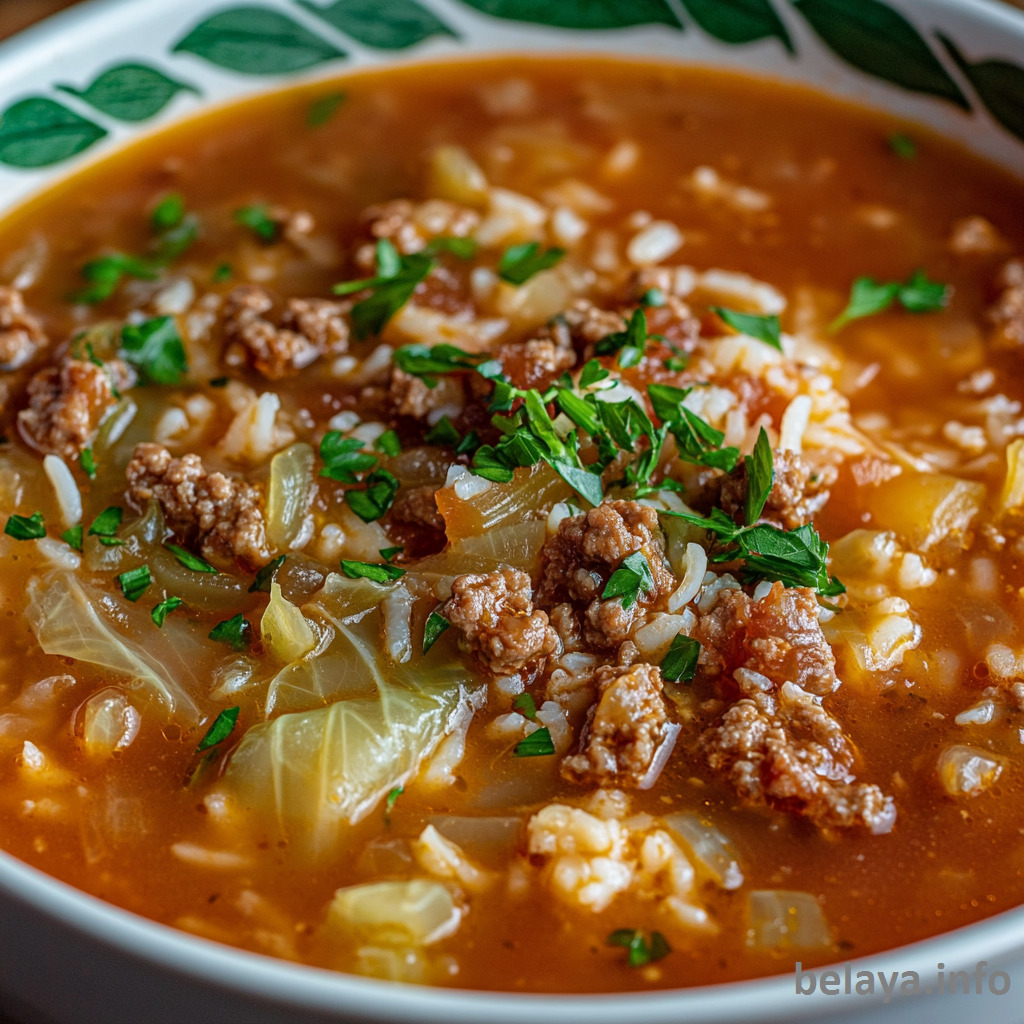
Instructions:
Heat the olive oil in a large pot over medium-high heat. Add the ground beef and season with salt and pepper to taste.
Cook, breaking up the meat with a spatula until beef is browned, approximately 4-5 minutes. Add the onion and garlic cook for 2-3 minutes.
Add the cabbage, carrots, beef broth, tomato sauce, rice, bay leaf, and brown sugar to the pot. Season with salt and pepper to taste.
Bring to a simmer and cook for 25 minutes or until rice is tender. Remove bay leaf and discard. Sprinkle with parsley and serve.

Important Notes When Making Cabbage Roll Soup:
The cut of the cabbage matters:
Use coarsely chopped green cabbage, not shredded. Larger pieces hold their texture during simmering and give the soup its signature bite, reminiscent of traditional cabbage rolls.
Carrots add natural sweetness:
Don’t skip the carrots—they bring subtle sweetness that balances the acidity of the tomatoes and the savoriness of the beef. Their flavor becomes more pronounced the longer the soup rests.
The tomato-to-broth ratio defines the soup’s body:
This recipe leans toward a thicker, stew-like soup due to the combination of tomato sauce and rice. If you prefer a thinner broth, you can increase the beef broth slightly or reduce the rice.
Rice continues to absorb liquid after cooking:
The longer the soup sits, the more the rice will expand and thicken the broth. If you’re making it ahead, consider undercooking the rice slightly or cooking it separately to stir in just before serving.
Use lean ground beef to avoid excess grease:
Opt for 90% lean beef or drain well after browning to keep the soup from becoming oily. A clean base allows the layered flavors—from the beef, cabbage, and aromatics—to shine.
Brown sugar softens the acidity but should be balanced:
Just a small amount adds warmth and depth, but too much can overwhelm the savory notes. Start with less and taste as you go—this soup is about balance, not sweetness.
A bay leaf builds quiet complexity:
Though subtle, the bay leaf adds a delicate herbal depth that lingers in the background. Don’t forget to remove it before serving, as its flavor turns bitter if left in too long.

How To Enjoy Cabbage Roll Soup After Cooking:
Let it rest before serving
After simmering, let the soup sit for 5–10 minutes off heat with the lid on. This allows the flavors to continue melding and gives the rice time to finish absorbing the broth without overcooking.
Serve it hot—but not scalding
Ladle the soup into warm bowls and let it cool slightly before eating. The layers of flavor—savory beef, sweet carrots, tangy tomato, and mellow cabbage—are more pronounced when the soup isn’t piping hot.
Finish with fresh garnishes
Right before serving, top each bowl with chopped fresh parsley or a squeeze of lemon for brightness. If you like a little heat, a pinch of red pepper flakes or a dash of hot sauce adds a bold contrast.
Pair it with hearty sides
Serve the soup with a slice of buttered crusty bread, rye toast, or garlic rolls to mop up the rich tomato broth. For a lighter option, a simple side salad with vinegar dressing balances the hearty texture of the soup.
Enjoy leftovers smarter
This soup tastes even better the next day. The cabbage softens further, and the flavors deepen. When reheating, add a splash of broth or water to loosen the texture, as the rice will continue to absorb liquid.
Freeze for later comfort
If you plan to freeze portions, consider freezing without the rice and adding fresh-cooked rice when reheating. This preserves the texture and prevents the soup from becoming overly thick or mushy.

Nutrition Information:
For 1 serving of Cabbage Roll Soup
Assuming the full recipe makes 6 servings:
Calories: 275 kcal | Total Fat: 13.2 g | Saturated Fat: 5.1 g | Monounsaturated Fat: 5.4 g | Polyunsaturated Fat: 0.9 g | Cholesterol: 52 mg | Sodium: 580–700 mg (depending on broth and added salt) | Total Carbohydrates: 22.6 g | Dietary Fiber: 4.2 g | Sugars: 8.3 g | Protein: 17.4 g

Frequently Asked Questions:
Can I use ground turkey or chicken instead of beef?
Yes, absolutely. Ground turkey or chicken works well for a lighter version. Just note that these meats are leaner, so adding a bit of olive oil while browning them can help build flavor and prevent dryness.
Will the rice overcook if I let the soup sit too long?
It can. The rice continues to absorb liquid as the soup rests or is stored. If making ahead, consider cooking the rice separately and adding it when reheating to keep it from getting mushy.
Can I freeze this soup?
Yes, but with one adjustment. For the best texture, freeze the soup without the rice, then add freshly cooked rice when reheating. This prevents the rice from breaking down and turning the broth too thick.
How do I make this soup vegetarian?
Simple swap! Replace the ground beef with cooked lentils, plant-based crumbles, or finely chopped mushrooms. Use vegetable broth instead of beef broth for a fully plant-based version.
Can I use purple cabbage instead of green?
Technically yes, but not recommended. Purple cabbage will work, but it may turn the soup a bluish or grayish color. Green cabbage is traditional and offers the best flavor and texture for this recipe.
Should I cook the rice separately or in the soup?
Cooking the rice directly in the soup is convenient and flavorful, as it absorbs the broth and seasonings. However, if you’re planning to store leftovers, cooking the rice separately and adding it when serving helps maintain the soup’s texture over time.
How finely should I chop the cabbage?
Coarsely chop the cabbage into bite-sized chunks—about 1- to 2-inch pieces. This size helps it retain texture during simmering and mimics the filling of traditional cabbage rolls, without becoming too soft or stringy.
When should I add the cabbage so it doesn’t overcook?
Add the cabbage with the broth and other vegetables, then simmer gently. It softens beautifully in about 20–25 minutes. Avoid overcooking, as cabbage becomes limp and loses its structure if left simmering too long.
Can I make this in a slow cooker?
Yes, absolutely. Brown the ground beef, onion, and garlic first, then transfer to a slow cooker. Add all remaining ingredients (except parsley) and cook on low for 6–7 hours or high for 3–4 hours, until rice and cabbage are tender.
How can I boost the umami or richness of the broth?
Add a splash of Worcestershire sauce, soy sauce, or a teaspoon of tomato paste while simmering. These ingredients enhance the meaty, savory depth of the broth without overpowering the classic cabbage roll flavor.
